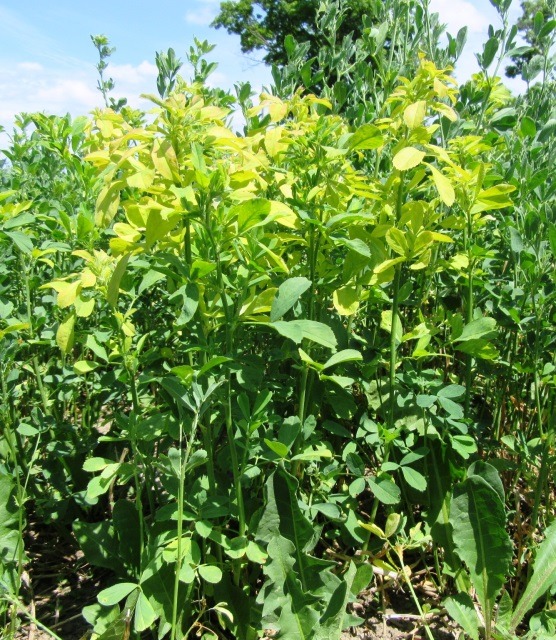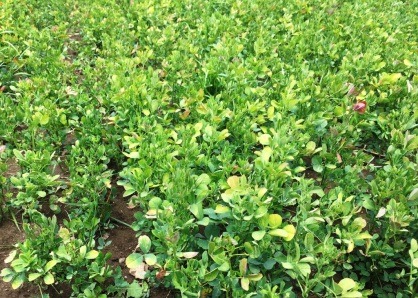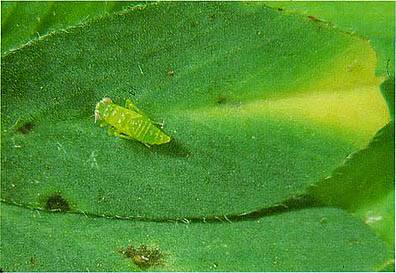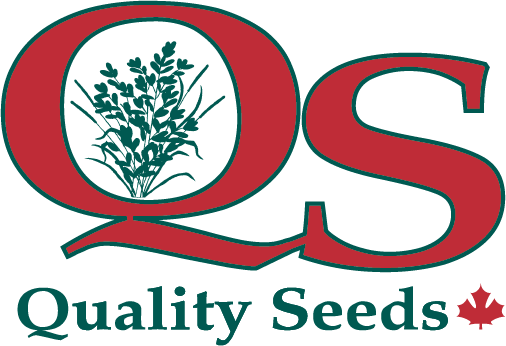Forage Update – July 3, 2020

First-cut quality this spring was excellent, but yields were often below average and forage inventories remain tight for many farmers. Dry weather has significantly reduced forage regrowth and second-cut yields in many parts of the province. Some areas are experiencing severe drought with little chance of rain in the forecast. Many drought-stressed alfalfa fields are also showing symptoms of boron and sulphur deficiencies, and some potato leafhopper damage.
There is some growing concern over having adequate forage inventories to meet livestock needs, with consideration of alternate forage options following winter wheat and other cereals.There were considerable acres of BMR sudangrass and sorghum-sudan seeded in June.
To Cut Or Not Too Cut?
A question often asked during extended periods of severe dry weather with poor growth is “should I cut or not?” Many dairy farmers are off schedule for their normal 4-cut system. We would like to stay on a 30 day cutting schedule to avoid losing a cut, but this may not be practical. Cutting decisions should be made on a case-by-case basis, depending on the growth and condition of the stand, and whether rain is in the forecast. Although alfalfa is deep-rooted and less affected by severe drought, it has the ability to go partially dormant. Moisture stress during the 2 weeks following cutting results in a reduced number of crown buds formed and stems per crown and reduced regrowth. Significant alfalfa regrowth will not occur until some drought-ending rains occur.
Short, drought-stressed alfalfa yields are significantly reduced, but forage quality is usually higher than normal, even when plants are flowering. Drought-stressed alfalfa wants to go reproductive earlier than normal. The stem internode length is reduced and the leaf-to-stem ratio is high. Harvesting at later maturity will allow alfalfa plants to build root reserves for better regrowth when rain returns.
As a general suggestion in severe drought situations, stands greater than 10 – 12 inches tall and in flower should be harvested. In stands less than 10 inches tall, delaying cutting is suggested because yields are typically lower than the cost of harvest, and mowing will further stress the plants and not increase growth until sufficient rainfall occurs.
To enable faster grass regrowth, grassier stands should not be cut less than 4 inches high. Drought-stressed new alfalfa seedings should not be harvested unless mowing is needed to control weeds.
Boron Deficiency In Alfalfa
Boron deficiency symptons can be seen in many alfalfa stands. It is characterized by a yellowing or reddening of the upper leaves of the plant, and is sometimes referred to as “yellow top”. Lower leaves will stay green. The field, or patches in the field, assume a bronze color. Stem growth between leaves becomes shortened, giving plants a stunted appearance. It is sometime confused with potato leafhopper damage, but with boron deficiency the discolouration appears on leaves at the top of the plant, while with potato leafhopper the discoloration appears on both the upper and lower leaves.
Growth can be severely stunted and winter hardiness reduced. Confirming a boron deficiency can be done by tissue testing with a properly taken sample and laboratory analysis. Boron deficiency can usually be corrected or prevented by a broadcast application of 1 – 2 lbs/acre of boron blended with the P and K. Refer to “Boron Deficiency in Alfalfa” www.qualityseeds.ca/post/boron-deficiency-in-alfalfa.


Figure 1 – Boron deficiency appears on the upper leaves of alfalfa, becoming yellow to red and stunting growth.
Potato Leafhopper Damage
Potato leafhoppers (PLH) are being reported at damaging levels in alfalfa in parts of the province. Damage is often confused with moisture and heat stress, and dismissed as “drought damage”. Insecticide control of PLH can significantly reduce drought stress and provide additional yield. New seedings are very susceptible and can be permanently damaged, so be sure to check these fields. Once the wedge-shaped yellow “hopperburn” is observed, the damage is done and it is too late for control. Refer to “Potato Leafhopper In Alfalfa” www.qualityseeds.ca/post/potato-leafhopper-in-alfalfa.




Figures 2 & 3 – Potato leafhopper “hopperburn” symptoms start as a “V” yellowish pattern on the leaf tips. Injury is most severe in new seedings and in young regrowth. (Photo credit – OMAFRA)
Alternate Forage Options
Many farmers are examining options to increase their forage inventories. An early winter wheat harvest enables more time for better volunteer wheat control and timely planting of alternate forage crops. Seeding oats or oat-pea mixtures in early-August following wheat for an early-October harvest as haylage or baleage can be a useful low-cost option for extending forage supplies. The challenges can sometimes be lack of adequate moisture in August for germination and growth, and having dry enough weather in October for adequate wilting. In wet falls, oat rust can be an issue. (Summer Seeding Oats For Forage http://fieldcropnews.com/2013/07/summer-seeding-oats-for-forage/)
Another suggested option is a mixture of annual ryegrass and berseem clover. These annuals have the advantages of quick establishment and good forage quality.
QS “Evolution” Italian ryegrass can produce very high quality, leafy, palatable forage suitable for high producing dairy cows. It can be seeded in August following wheat for harvest in late-fall and then again the following May, making it an excellent double-crop option if managed properly. Evolution is noted for its high fibre digestibility (NDFD), high relative forage quality (RFQ), palatability, ease of establishment, and its yield response to nitrogen.
